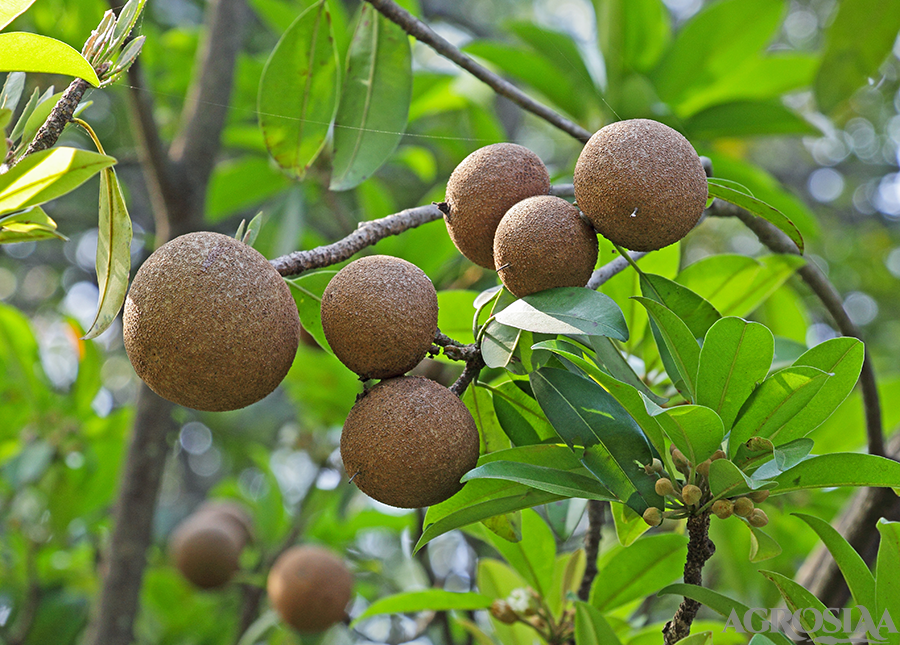Chikoo
Sapotaceae
Manilkara achrus1
Cricket ball, kalipatti, CO2, PKM-1, Oval Guthi, Culcutta special round Hybrid- CO-1, PKM-2, PKM-3, DSH-1, DSH-2
The planting of grafts is done from June to October.
The Sapota is a tropical fruit crop and can be grown from sea level upto 1200 m. height. It prefers a warm and humid weather and grows in both dry and humid areas. Areas with an annual rainfall of 125-250 cm are highly suitable. The optimum temperatures ranges between 12 degree cent. To 36 deg. Cent.
The sapota tree is a hardy perennial and evergreen tree and can be grown on a wide range of soils. Drainage is most important. There should not be a hard pan in the sub soil. Deep and porous soils make a good growth. The sapota can tolerate the presence of salts in the soil or in irrigation water to some extent.
Pits of 1 x 1 x 1 m at the distance of 8 x 8 or 9 x 9 or 10 x 10 m are dug well before the onset of monsoon. The pits are filled in with a well decomposed manure, 5:10:5 mixture single super phosphate neem cake and a mixture of micronutrients.
The planting of grafts in field.
Appropriate time of planting grafts in the month of June to October.
Distance between two rows 9 m Distance between two plant is 9 m Or 8 x 8 m , in heavy soils distance should be kept 10 x 10 m
100 to 120 plants /ha
The sapota has a long pre bearing age and wider spacing allows enough interspace for growing certain crops for few seasons. The short duration fruit crops like banana, papaya, pineapple, vegetables, different types of lillies, groundnut, chilli gram, frenchbean , cowpea, onion etc. are suitably grown for some seasons. Frequent weeding or mulching is necessry for first few years.
For healthy growth and good quality fruits manures are fertilizers should be applied regularly. The trees should be fertilized twice in a year during June and January. A well grown tree should be supplied with 100 kg Biomeal 2.5 kg , 5: 10 : 5 NPK, 1 kg ormichem or other micronutrient mixture. The foliar sprays of NPK, MG and Zn are useful to increase the fruitset and improve the size of fruit.
Though sapota can tolerate drought conditions to some extent, yet it respond well to irrigation. As the tree is perennial evergreen and almost growing cum fruiting stage every year. Whenever is necessary must be provided.
gap filling and weeding should be done whenever necessary. Young plants ar likely to damaged due to the scorching sun, dry and hot wind and frost,Necessry protective are sdopted.
Leaf spot , sooty mould and flatenned branches
Stem borer, scale insects, leaf webber, mealy bug, leaf minor, bud eating catterpillar, Barkeating caterpillar and fruit borer. The suitable control measures are adopted. Clean and well nourished orchard is affected less. Carbary, malathion, Dimitods, Bavistin, Kuman etc should be sprayed alternatively apart from following clean cultivation.
Training and pruning- In sapota a strong central stem is necessary. The sapota in general has a well balanced distribution of branches and the crown assumes a uniform shape. There is no necessity of prunning every year. All the growths those appear on the root stock below the graft joint must be removed. After ¾ years of planting, the lowermost branches upto a height of 1 m may be removed. Similarly overshaded and crowded branches are also removed. In sapota new growth and flowering occur simultaneously and it has a mixed type of bearing habit. Flowers and fruits appear in the leaf axils in the new growth and hence pruning of branches should not be done. Also bee keeping to increase fruit setting (10%).
Sapota is a climacteric fruit and it improves in quality after harvesting but immature fruits should never be harvested.
(Qtls /ha) A well grown and well nourished sapota tree yields 2500-3000 fruits weighing about 150 kg every year for 50-60 years during its productive age.
After harvesting fruits should be kept in plastic cretes or boxes for marketing.
well matured fruits ripen within 3/5 days after harvest and can be stored for 10-12 days in 12 0c temperature.
The sapota when fully ripe is delious and is eaten as dessert fruit. The pulp is sweet and melting. Besides food values the sapota fruits are also used in some aurveda preparations.
Graded fruits are packed in boxes and then transported to distant markets. For local markets the fruits are washed in water and carried in baskets or gunny bags. Pulp of sapota fruit is used for canning and juice purpose.
Maharashtra, Gujarat, karnataka and Tamil Nadu
-










